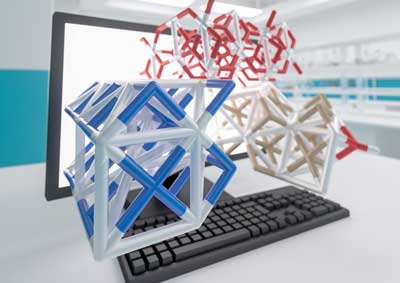| Aug 05, 2020 | |
Sustainable chemistry at the quantum level(Nanowerk News) Developing catalysts for sustainable fuel and chemical production requires a kind of Goldilocks Effect - some catalysts are too ineffective while others are too uneconomical. Catalyst testing also takes a lot of time and resources. New breakthroughs in computational quantum chemistry, however, hold promise for discovering catalysts that are "just right" and thousands of times faster than standard approaches. |
|
| University of Pittsburgh Associate Professor John A. Keith and his lab group at the Swanson School of Engineering are using new quantum chemistry computing procedures to categorize hypothetical electrocatalysts that are "too slow" or "too expensive", far more thoroughly and quickly than was considered possible a few years ago. Keith is also the Richard King Mellon Faculty Fellow in Energy in the Swanson School's Department of Chemical and Petroleum Engineering. | |
| The Keith Group's research compilation was featured in Interface ("Computational Quantum Chemical Explorations of Chemical/Material Space for Efficient Electrocatalysts"), a quarterly magazine of The Electrochemical Society. | |
 |
|
| The image represents atomic scale structures of different materials (carbides, nitrides, and oxides) coming out of a screen of a computer in a scientific laboratory. The computational alchemy procedure reported in article number 1800142 by Charles D. Griego, Karthikeyan Saravanan, and John A. Keith leverages a few Kohn-Sham density functional theory calculations for high-throughput screening of novel material catalysts with minimal computational effort. ((High Throughput Screening: Benchmarking Computational Alchemy for Carbide, Nitride, and Oxide Catalysts. | |
| "For decades, catalyst development was the result of trial and error - years-long development and testing in the lab, giving us a basic understanding of how catalytic processes work. Today, computational modeling provides us with new insight into these reactions at the molecular level," Keith explained. "Most exciting however is computational quantum chemistry, which can simulate the structures and dynamics of many atoms at a time. Coupled with the growing field of machine learning, we can more quickly and precisely predict and simulate catalytic models." | |
| In the article, Keith explained a three-pronged approach for predicting novel electrocatalysts: 1) analyzing hypothetical reaction paths; 2) predicting ideal electrochemical environments; and 3) high-throughput screening powered by alchemical perturbation density functional theory and machine learning. The article explains how these approaches can transform how engineers and scientists develop electrocatalysts needed for society. | |
| "These emerging computational methods can allow researchers to be more than a thousand times as effective at discovering new systems compared to standard protocols," Keith said. "For centuries chemistry and materials science relied on traditional Edisonian models of laboratory exploration, which bring far more failures than successes and thus a lot of wasted time and resources. Traditional computational quantum chemistry has accelerated these efforts, but the newest methods supercharge them. This helps researchers better pinpoint the undiscovered catalysts society desperately needs for a sustainable future." |
| Source: University of Pittsburgh | |
|
Subscribe to a free copy of one of our daily Nanowerk Newsletter Email Digests with a compilation of all of the day's news. |
